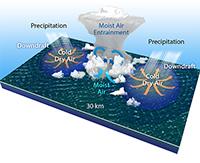A Breath of Cold Air: scientists discover the truth behind the role of cold air pools in climate
Warm, moist air—colliding with cold dry air above it—has traditionally been credited with creating massive cloud formations many miles tall. The assumption of how these so-called deep convective clouds grow is well engrained in current models to study global climate change and predict weather. Now, research by a team of scientists from Pacific Northwest National Laboratory and academia challenges that long-held belief.
As reported in the Journal of Advances in Modeling Earth Systems, the scientists discovered that cold air near the surface rather than warm air is more likely to fuel cloud growth. Deep clouds tend to grow best at the edge of several nearby intersecting cold pools, the puddles of cold air left when raindrops evaporate as they fall. The cold pools push newly developed clouds closer together, adding moisture to the local environment and increasing the probability for clouds to grow deeper.
Researchers at PNNL and collaborators from the University of Washington and Oregon State University used the high-resolution Weather Research and Forecasting Model with data collected over the Indian Ocean near the equator. This real-world observation data came from ground-based radar and ship-based instruments operated during the Atmospheric Radiation Measurement (ARM) Climate Research Facility's Madden-Julian Oscillation Investigation Experiment (AMIE) and the Earth Observing Laboratory's Dynamics of the Madden-Julian Oscillation (DYNAMO) research campaign in 2011. Scientists used the model to track cold air produced by rain and the clouds that formed around the cold pools.
By following the lifecycle of thousands of cold pools and the new clouds that developed around them, the researchers teased out the secret of deep convective cloud development over tropical warm oceans. Their work demonstrated that intersecting cold pools last more than twice as long as isolated cold pools and are twice as large and nearly two-thirds deeper. More persistent rainfall produced longer lasting, larger, deeper, and colder cold pools. More new clouds tend to form around these intense cold pools as they collide, and the aggregation effect fuels the growth of deep convective clouds, ultimately affecting weather around the world.
Deep convective clouds drive climate in the tropics and play a large part in rainfall and air circulation around the world. Depicting them accurately in models affects how well scientists can predict weather today and climate change in the future. The deeper clouds grow, the harder it is to simulate them accurately.
"The resolution of today's climate models is too coarse to simulate individual clouds," says Dr. Zhe Feng, the atmospheric scientist at PNNL who led the study. "These models must rely on formulas, which struggle to match observations of storm clouds and precipitation in part because they do not represent how cold pools operate."
Sponsors: The research was supported by the U.S. Department of Energy, Office of Science, Office of Biological and Environmental Research under the Atmospheric System Research Program and the Regional and Global Climate Modeling Program.
Facilities: Scientists obtained data from the ARM Climate Research Facility and the National Center for Atmospheric Research Earth Observing Laboratory's DYNAMO Data Catalog. The Oak Ridge Leadership Computing Facility (through the INCITE Climate End Station project) and National Energy Research Scientific Computing Center provided computing resources.


